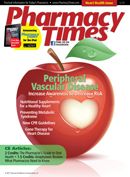Publication
Article
Pharmacy Times
Outlook: Obesity
School Vending Machines Steer Snacking Habits
A recent study shows vending machines in schools have a powerful impact on kids’ dietary intake— for better or worse. Whether they are packed with calorie-laden snacks and sodas or healthy apples and oranges, these lunchroom mainstays play a major role in determining food choices.
“Schools are in a powerful position to influence the diets of children,” wrote Alisha J. Rovner, PhD, lead author and researcher for the Eunice Kennedy National Institute of Child Health and Human Development, part of the National Institutes of Health. She said schools have a responsibility to encourage healthy eating—starting with the contents of vending machines.
Of the 152 schools Dr. Rovner and her colleagues studied, 83% stocked vending machines with foods of minimal nutritional value, including chocolate, candy, soft drinks, and salty snacks. The researchers observed a direct relationship between consumption and availability—children in these schools ate more sweets overall. In schools where fruits and vegetables were sold in vending machines, children ate more produce.
“The most salient point is that we link school vending machine content to student diet,” said Ronald Iannotti, PhD, a coauthor of the study. He argued that school wellness policies should include guidelines for stocking vending machines in order to foster “an optimum environment for child health.”
Can High-Tech Gadgets Lower BMI?
The federal government is banking on new technologies to help young adults reach a healthy weight. The National Institutes of Health’s (NIH’s) National Heart, Lung, and Blood Institute (NHLBI) announced it would invest $36 million to fund 7 clinical trials that combine behavioral weight management programs with technologies embraced by the 18-to-35 set.
These include text messaging and social networking, as well as gadgets specifically designed to promote weight loss and maintenance, such as Bluetooth-enabled scales and wearable exercise monitors. Called the Early Adult Reduction of Weight through Lifestyle Intervention (EARLY) trials, the project aims to protect young adults from the heart risks associated with obesity.
Weight gain is especially prevalent among adults in their 20s, who gain an average of 3 pounds per year, according to prior NIH research. Although the rate of weight gain among young adults is well researched, fewer studies have focused on identifying strategies to motivate this high-risk group.
“These studies have the potential to teach us about successfully engaging young adults in achieving a healthy weight at a critical time in their lives,” said Susan B. Shurin, MD, director of the NHLBI. “These studies are designed to provide evidence to help us guide young adults toward approaches that work.”
High-Protein, Low-GI Foods Fight Rebound Pounds
New research suggests dieters should include the glycemic index (GI) on their list of need-to-know nutrition facts. In a large European study, researchers found that a combination of high-protein foods and low-GI carbohydrates was the best diet for maintaining weight loss.
The GI ranks foods on a 100-point scale based on how quickly they raise blood sugar levels. A value of 70 or higher is considered high; anything below 55 is considered low. “Low impact” carbohydrates include whole grain breads and pastas, bran and oat cereals, and many fruits and vegetables.
Previous studies on the GI have yielded mixed results, according to study coauthor Thomas Meinert Larsen, PhD, associate professor at the University of Copenhagen’s Department of Human Nutrition. His research supports the use of GI values as a weight management tool, however.
Dr. Larsen and colleagues asked 938 adults, all of whom had lost an average of 24 pounds, to follow 1of 5 maintenance diets for 6 months. Those who adhered to a low-GI, high-protein diet had the best results, with an average regain of 2 pounds less than the comparison groups. The worst diet was a high-GI, low-protein diet, which caused an average regain of 3.6 pounds.
Even modest changes are sufficient to keep rebound pounds at bay. Swapping refined sugars for complex carbohydrates and eating more lean protein and fibrous fruits and vegetables are steps patients can take to incorporate the GI into their maintenance diets. PT







